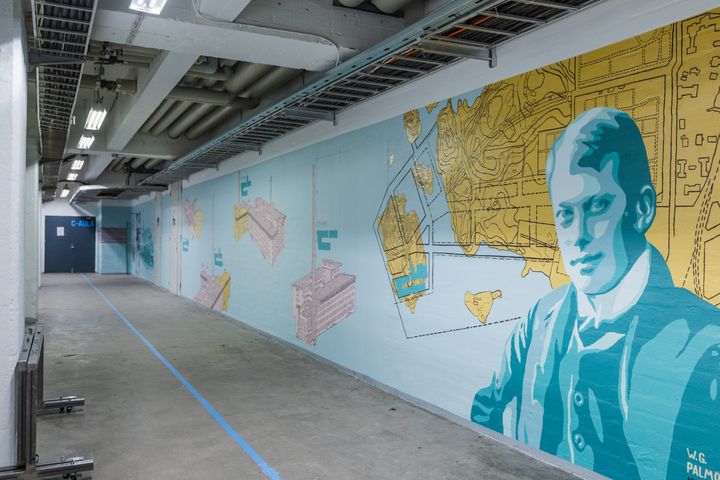
Cable Factory opens a history corridor – murals tell a story of nearly a hundred years
Cable Factory celebrates its industrial and cultural centre history by opening in November a series of murals covering nearly 200 square metres in its basement spaces. Created by artist Ruusa, the works depict the story of Cable Factory’s transformation from an industrial plant into a vibrant cultural hub. The history corridor becomes part of the Cable Factory Round tours, offering visitors an opportunity to explore the building’s past.

Artist Ruusa’s murals portray the history of Cable Factory across almost one hundred years. The series comprises 14 paintings of various sizes, covering a total of around 200 square metres.
-It has been an honor to work with the history of Cable Factory. The encounters with the building’s tenants and the stories they shared during the painting process have brought additional depth to the works, Ruusa says. - I hope that the series of murals brings new life to the space and serves as a link for visitors between Cable Factory's past and its vibrant present, a present whose history we will no doubt continue to hear more about in the future, she continues.
The murals move from the early days of cable manufacturing and undersea cable production to the era of telecommunications and Nokia’s mobile phone development, as well as the activities of the Pro Kaapeli association. Ultimately, they lead toward today’s cultural centre and its diverse community of operators.
The works highlight key figures in Cable Factory’s history: engineer Arvid Wikström, founder of Finland’s first cable company, and the factory’s early directors, Olympic champion Verner Weckman and industrialist Björn Westerlund.
The walls feature Jörn Donner and Erkki Tuomioja, who played a significant role in the City of Helsinki’s decisions regarding Cable Factory’s future. The murals also depict the first artist tenant, guitarist and composer Raoul Björkenheim, as well as architect Pia Ilonen and long-time property manager Soile Kaukolander, whose contributions are still visible in Cable Factory’s present-day appearance and operations.
Along the route, visitors will also encounter a smaller version of the Radio City neon sign, which was relocated from Lepakko to Cable Factory’s end wall, where it remained for more than 20 years. Both the original sign and its miniature were crafted by Suomi-Neon.
-Cable Factory’s history corridor is a tribute to the building’s past and to street art. Ruusa’s murals beautifully highlight Cable Factory’s role as a transformative force in Finnish industry until the late 1980s, and as the country’s largest cultural hub from the early 1990s to the present day, says KAAPELI’s CEO Kai Huotari.
Part of Cable Factory Round – the tour evolves and expands
The history corridor becomes part of the Cable Factory Round, to be released later and designed for all visitors. It will include both guided and self-guided tours showcasing Cable Factory’s vibrant history and wide-ranging contemporary activities. The tour and history corridor will gradually expand with new sections.
-At the end of the corridor, we will open a graffiti gallery next summer. The artist will be selected through an open call at the beginning of next year. We also plan to create a tribute to Jörn Donner, the first chair of KAAPELI’s board, Huotari outlines.
The history corridor is open to everyone
The history corridor is located on Cable Factory’s Baana, along the route that leads from the Glass Courtyard down to the basement, toward staircase C.
It is open to everyone during Baana’s opening hours (Mon–Sun 7.30–21), and can also be explored independently.
The app-based Cable Factory Round is set to launch at the end of this year. Guided group tours will begin during next year.
More information:
Kai Huotari, Managing director, KAAPELI (Kiinteistö Oy Kaapelitalo), kai.huotari@kaapeli.com, tel. +358 50 384 1557
Artist Ruusa, Rosa Hultman, rosa@ruusaart.com, tel. +358 40 703 5999
Keywords
Images
KAAPELI (Kiinteistö Oy Kaapelitalo)
KAAPELI (Kiinteistö Oy Kaapelitalo) is a property management company owned by the City of Helsinki. It runs and develops three cultural centres in Helsinki: Cable Factory, N10 and Suvilahti.
KAAPELI owns, renovates and rents out old industrial buildings. The company’s goal is to provide functional and inspiring spaces for the needs of the arts, culture and the creative fields and ensure the best possible conditions for its tenants to operate. KAAPELI manages around 100,000 m² of space, offering the setting for hundreds of cultural events each year and a working environment for more than 700 operators. Altogether, the centres welcome around 1.5 million visitors annually.
Alternative languages
Subscribe to releases from Kiinteistö Oy Kaapelitalo
Subscribe to all the latest releases from Kiinteistö Oy Kaapelitalo by registering your e-mail address below. You can unsubscribe at any time.

